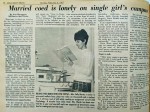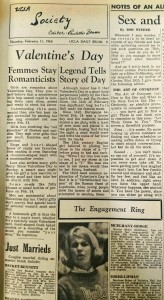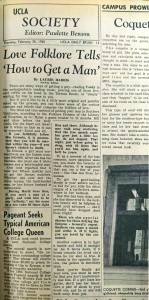Elle Woods – the perky blonde sorority girl who used her social acumen to crack a murder case wide open – has been haunting college relationships since 2001.
Who can forget her naive belief her college boyfriend was “the one” she was destined to marry? Despite her conviction, at the end of their college careers at “CULA” – a screenwriter’s bastardization of UCLA – her boyfriend breaks up with her to go to law school across the country, leaving her friends to lament, “We thought she’d be the first to walk down the aisle and now she’s totally adrift.”
“Legally Blonde” satirized society’s traditional dismissal of women in higher education as “pre-wed” students instead of serious contenders in the job market. The film, released near the turn of the century, represented a paradigm shift for women in higher education after a literal shift in the college gender gap during the ’90s.
In 1991, American women aged 25 to 29 with college degrees outnumbered men for the first time. In the mid-2000s, more than 50 percent of college-educated women ages 25 to 29 had never been married.
In 1967, The Bruin featured a group of married female students seeking to build a community on a “single girl’s campus.” Staff writer Ann Hasegawa reported these women stood out among their peers as already married, instead of looking to marry.
Alongside the feature ran a photo of Sally Bierke studying child psychology while preparing a pot of chili, illustrating the perfect harmony she’d achieved between being a homemaker and an educated woman – never mind that her textbook implied Bierke was looking forward to motherhood instead of pursuing private practice after acquiring her bachelor’s degree.
This gendered perspective of women’s roles on college campuses was widespread.
In fact, through the 1960s, The Bruin published a “Society” section, which hosted columns like “Femmes Stay Romanticist,” “Love Folklore Tells ‘How to Get a Man'” and regular engagement and marriage announcements.
In a piece titled “Sex and the Simple Girl” – featured on Valentine’s Day in 1965 – Bob Wieder advised young men on the arts of “conquest,” “keeping her” and “the kill.” “A broad who comes over to ask you about school is a fraud,” he wrote. “She could really give a damn about your finals.”
The dean of women at the time, Nola Stark, opposed this conservative view of women’s roles on campus. “Girls don’t have much conflict with their role as wives, but it seems that the people they deal with hold traditional concepts that they should be home taking care of their husband who is at work,” Stark told The Bruin. Or in Wieder’s case, it’s the less-traditional, but still-misogynistic concept that no woman could possibly be more interested in education than in ensnaring a man.
Despite the expectation that they would be homemakers, women in college in the ’60s were no less serious about doing well in school. Kasegawa reported, “In considering marriage, coeds advised not to get married at too young an age. The “right” age was decided to be 23.”
Indeed, in 1960, the typical age for college-educated Americans to be married was 23 years old. In 2008, however, Americans were typically waiting until they were 28 years old to marry.
Today, the statistics suggest not only that college-educated women and Americans in general are marrying later in life, but also that they’re feeling less compelled to marry at all. About one-third of never-married adults today are unsure if they ever want to marry, and an additional 13 percent are sure they don’t. Despite their doubt, only 27 percent of college-educated Americans believe marriage is becoming obsolete.
It’s not so much that marriage is dying out, but that the gender roles that have driven it as an institution are slowly fading into the past – admittedly at a slower pace for communities without access to higher education.
For those of us with the opportunity, however, the belief that a woman in college is only in it for the college-educated husband is now laughable.
This sort of advice is now an old joke about the generational gap and the inspiration for films like “Legally Blonde,” which capitalize on stereotypes of femininity only to subvert them.


